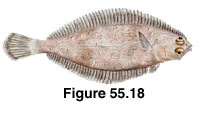 Description
Description
Lyopsetta exilis (Slender Sole)
(Other common names: Rough Sole)
Figure 55.18
 Description
DescriptionLength: 35 cm.
Mouth: large, terminal; wide gape; asymmetrical; jaws extend to middle of lower eye; maxillary extends to anterior edge of the lower eye; teeth well developed in both jaws; lower jaw has two rows of teeth; snout blunt and pointed.
Body: caudal peduncle moderate; caudal fin rounded; lateral line gently slopes from head to pectoral region and then horizontal; accessory branch absent.
Color: pale brown on eyed side with dark margins in scales; pale orange to white on blind side; fins dusky.
Depth: up to 500 m.
Habitat: soft substrate but will also move into shallow sandy/rocky areas.
Season: spawns in spring (April).
Diet: crustaceans, worms, and molluscs.
Predators: not determined.
Distribution: southern California to Alaska.
 Scale Description
Scale DescriptionType of Scale: ctenoid on eyed side and mostly ctenoid on blind, but some cycloid on central area under dorsal fin.
Relative Scale Size: large.
Position of Scales on Body: along lateral line to dorsal fin; on dorsal, caudal, and anal fins; on blind side; imbricated; deciduous and easily shed (Hart, 1973).
Overall Scale Shape: generally oval (some regenerated scales are more circular) with elongated lateral fields. Area of the anterior field is smaller than area of combined lateral fields (Batts, 1964).
Focus and Circuli: the focus is positioned approximately one-sixth to one-seventh of the total scale length from the outside margin of the posterior field, abuting the edge of ctenii growth. The circuli are generally continuous between the lateral and anterior fields (except where broken by radii) but the circuli in the shorter posterior field are compacted (Batts, 1964). Exposed field extends anterior to the focus, a distance greater than the distance from the posterior edge of the ctenii to anterior edge of the bases of the ctenii (Batts, 1964).
Radii: numbers are variable and not diagnostic, but the reference collection suggests that there are at least one (rarely two) secondary radii before the first primary on both sides of the anterior field. Radii are present only in the anterior field (Batts, 1964). Intermarkings are absent (Batts, 1964). The outer edge of the anterior field is slightly scalloped and convex (not expressed in regenerated scales).